No products
Categories
- Fashion Accessories
- Clothing
- Beauty & Lifestyle
-
Hi-Tech & Lifestyle
- Gaming
-
Case
- iPhone 11 Pro
- iPhone 11 Pro Max
- iPhone 11
- iPhone X / XS
- iPhone XS Max
- Samsung S10 / S10+ / S10e
- Huawei P30 / P30 Pro / P30 Lite
- Huawei P20 / P20 Pro / P20 Lite
- iPhone XR
- Samsung S9
- Samsung S9+
- iPhone 8 / 7
- iPhone 8 Plus / 7 Plus
- Samsung S8
- Samsung S8+
- Samsung S7
- Samsung S7 Edge
- iPhone 6 / 6 s
- iPhone 6 Plus / 6 s Plus
- iPhone 5 / SE
- Skin
- Audio
- Smart Home
- Drones & Hoverboard
- Photo & Video
- Desk Supplies
- Accessories
- Games
- Beverages
- Food
- Home
- Jewelry
- Luxury
- Travel
- Art
- Footwear
- Vintage Fashion
- Restaurants
- Sport
- Animals
- Gift Ideas
- Kidswear
Extra
Viewed Products
-

Miu Miu - Miu Miu La Mondaine Sunglasses - Cat-Eye - Smoky Gray - Sunglasses...
Sleek, feminine silhouette framed by...
-

Ammoment - Python in Calcite Blue - Leather Pete Clutch Bag
Handmade leather pete clutch bag in...
-

Jimmy Choo - JC Lip Gloss Colour - Ruby Red - Exclusive Collection - Luxury...
Ruby Red is a dramatic shade with...
Giuseppe Corrado
Biographical Notes: A Radical Choice of Life
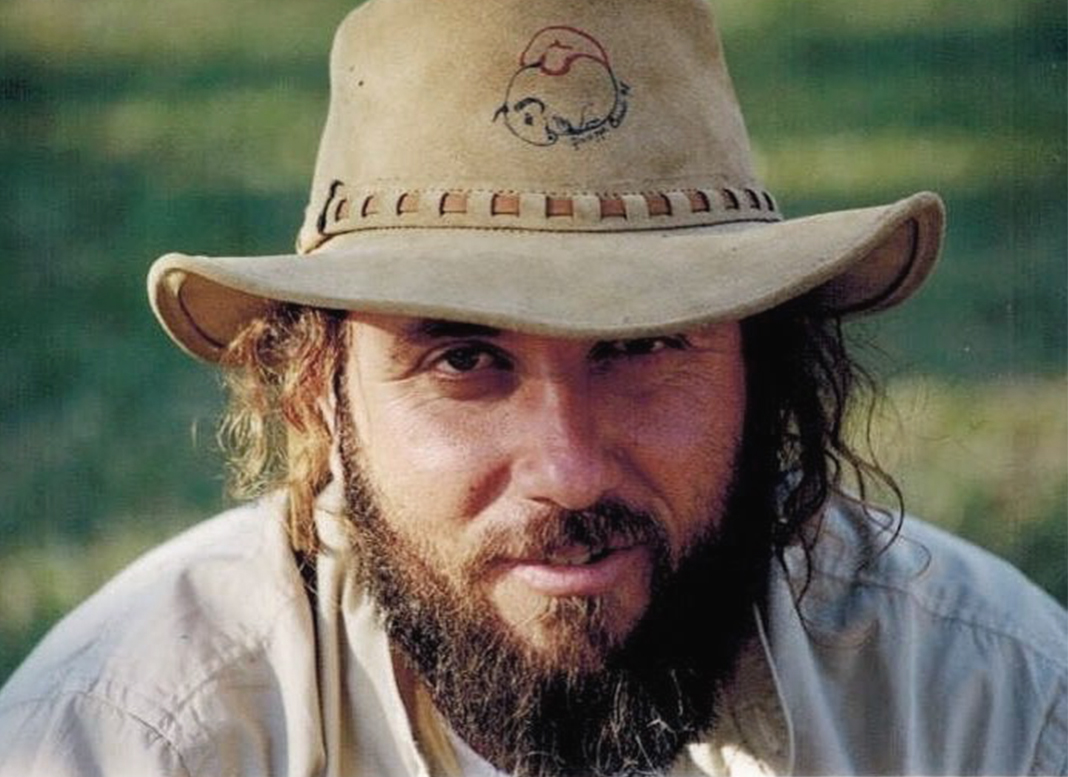
Giuseppe Corrado was born on January 1, 1960 in Montesano Salentino, in the province of Lecce. At the age of 14, he enrolled in the Artistic Lyceum of Lecce, where he graduated and subsequently decided to enroll in the University of Sports Sciences in Foggia. After obtaining this further qualification, he starts for a short phase of his life at school as a physical education teacher, but that "guerrier spirit that enters me roars" (a creative fury, experienced as a pleasure principle irrepressible) leads him to drop out of school and devote himself to the activity of sculptor and painter.

So he makes a radical and unconventional lifestyle choice. The choice of a petty-bourgeois life, protected from any risk and danger, would have been much more accommodating and safe. As is evident, in this choice, there is a great desire for transgression and rupture, but also an unshakable trust in one's artistic means. It is a choice that totally involves his family, starting with Anna Maria, his splendid wife. However, to tell the truth, his four children have also fully integrated into this modus vivendi.

He, in a very short time, clarifies, first of all to himself, his attitudinal inclinations and, for this reason, he decides to devote himself essentially to sculpture. Do not hesitate to return to the art books. He studies the Greek-Latin classics, medieval iconography and the Italian Renaissance, without however consecrating tradition in dogmatic assumptions. He also begins to be interested in avant-garde and experimentation, but avoiding the easy enthusiasm of conformism and fashion.
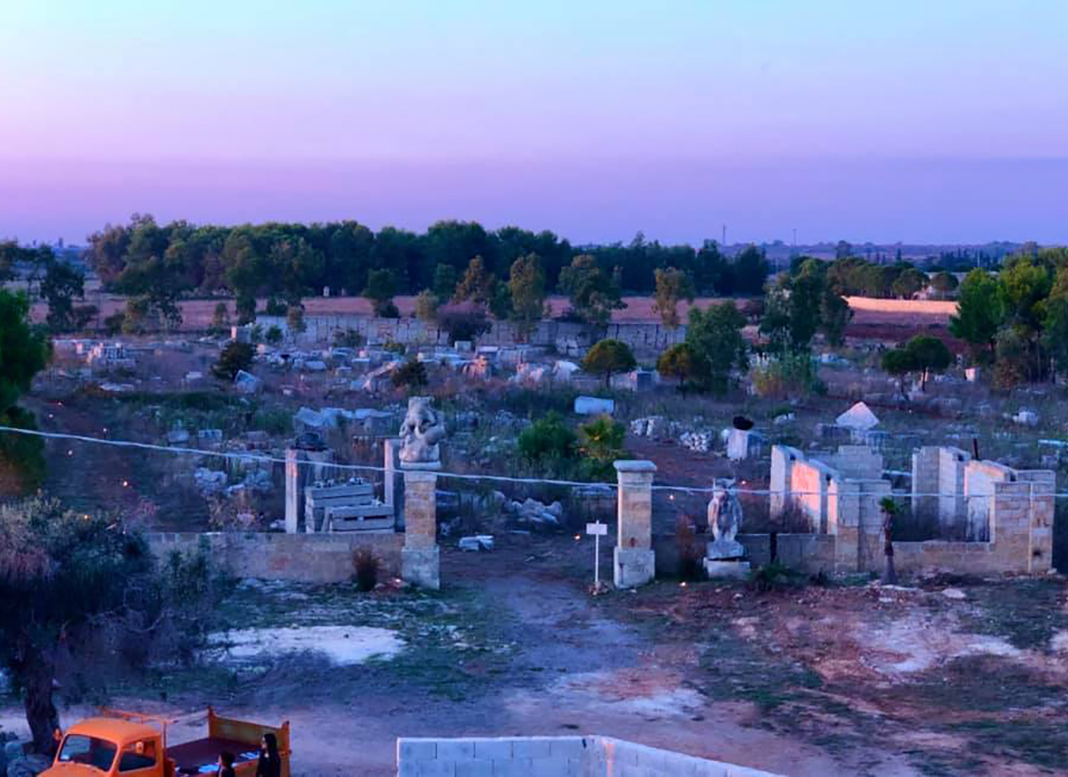
Giuseppe Corrado alternates painting with sculpture, but sculpture is soon to establish itself as a prevalent activity (although he will never completely abandon the canvas). He reads a lot and follows the modern debate on art, the extreme theses of the various schools and the many controversies that follow. Its favorite author is Giulio Carlo Argan. It is through these multifarious interests that he begins to form an aesthetic taste, destined to become his style.

When he begins this adventure, he is 22 years old, but that "warrior spirit" roared in his soul, for almost a decade, a period in which the dispositions of the nature had already disciplined the hand and achieved results. The phase of doubt and, therefore, of the co-presence, between the teaching activity and the artistic activity, is over forever. Giuseppe Corrado has never regretted his radical choice.
Paris: A Prestigious Award
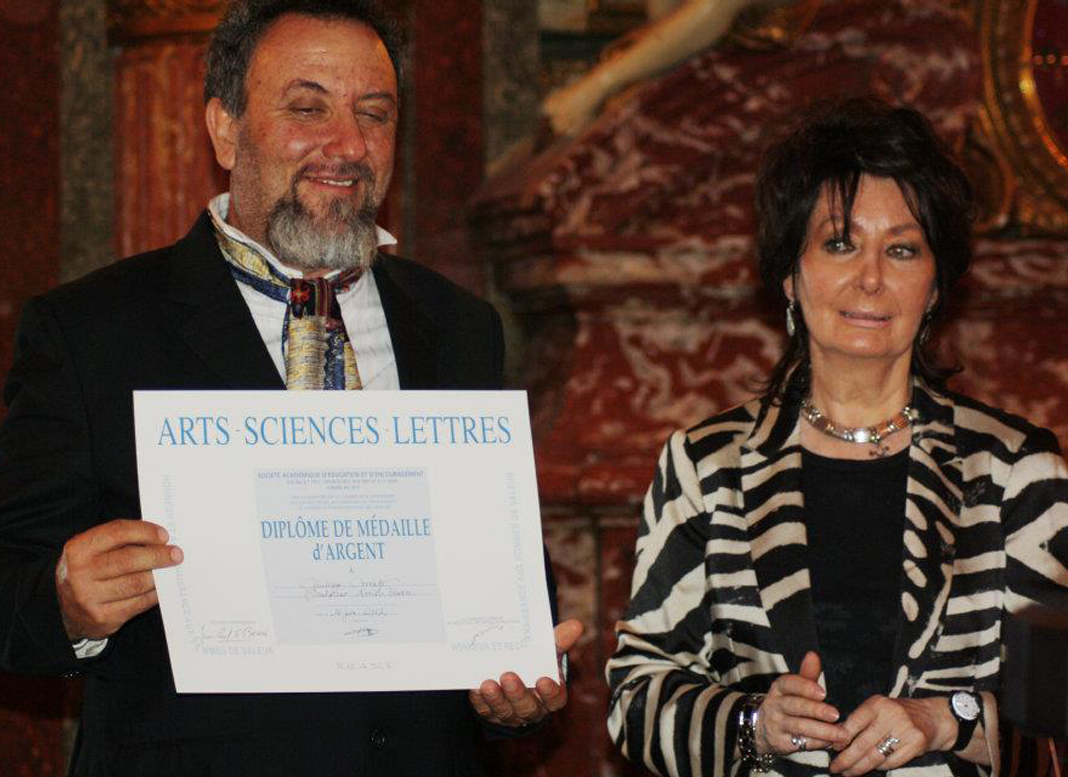
Thirty abundant years have passed since the first naive experiences of Giuseppe Corrado and many tests have been faced and brilliantly passed: school, training, assimilation of models, the search for one's own language and also the achievement of a substantial reputation . There are also many critical voices that have recognized the artistic value of his works and not only in Italy. The confirmation comes from a prestigious cultural recognition, attributed to him in June 2012 in Paris, a city that evokes, on a planetary level, suggestions of excellence in the field of the arts, creativity, culture and research. Here he was awarded, during a solemn ceremony, the Diplôme de Médaille d’Argent in Art and was, at the same time, identified as the best living Italian sculptor.
A truly exceptional achievement. The prestigious award is the result of a careful selection work, carried out by experts in the sector who carried it out over a long period of time on the mandate of the "Arts-Sciences-Lettres" -Societé Académique d'Education et d ' Encouragement. It is an association that has been operating since 1915 with fairly strict criteria in identifying excellence, the validity of which is, moreover, unanimously recognized within the cultured community. Amazement and satisfaction are the feelings with which Giuseppe Corrado received the news, however, lived with the usual spirit of humility, being his soul devoid of worldly inclinations and vainglory. The official ceremony, during which he received the Diplôme de Médaille d’Argent, took place on June 16, 2012 at the Hotel Intercontinental Paris le Gran in Paris. It was attended by well-known personalities from the world of culture, the arts and entertainment, as well as leading figures from the political, journalistic and civil society world. A great success both for the public and for critics.
Mediterranean Roots and Cosmopolitanism: Nelson Mandela

Giuseppe Corrado is an artist who knows how to combine the cosmopolitan openness of his sculptures with the solidity of very deep anthropological roots. For this reason, the Mediterranean and the world are two interchangeable dimensions and, in both, the negative existentialism of the human condition is hosted. He assumes that ethno-place that is the Mediterranean, that is, a symbolic-cultural system, mixed with land and sea, as if it were the archaic centrality of a remote world, still significant and not as a moribund periphery. And here, in his works, the re-proposition of Hellenism and classical mythology in a perspective, however, contemporary. And here, again, that baroque sui generis and dramatic that makes one think of the metaphor of storms and an instability of being that gradually passes from aesthetics to anthropology to ethics. In this perspective, the Mediterranean itself expands towards the meaning of the global world.
It would be wrong, however, to think that the myth of the roots was experienced by Giuseppe Corrado as a hermetic entrenchment in an ahistorical vision of those cultural symbolisms, anthropologically linked to Mediterranean civilizations. He has a very open vision of art to such an extent that his need for conviviality between cultures has led him to consider the Mediterranean-World space as the most suitable to show his works, to let them unleash emotions in their abilities receptive to very different peoples and distinguished personalities.
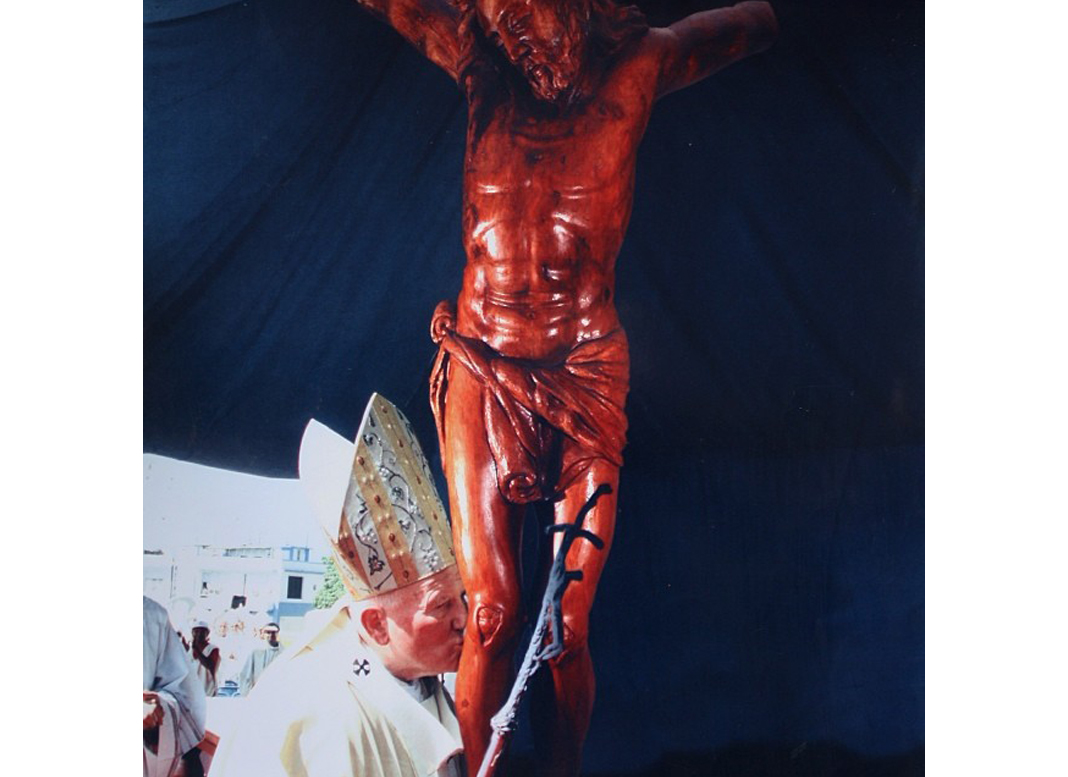
Jesus, olive wood, 1994. Giuseppe Corrado is a cosmopolitan sculptor for wanting to bring a message of critical reflection and peace to many places in the world, from the most important Italian and European cities to Hong Kong and South Africa. Famous in this sense is the great wooden Jesus, donated in 1994 to Pope John Paul II and the embrace with Nelson Mandela, in 1998, to whom he paid homage to one of his important works entitled the Salento Sun. He feels he belongs to a world agora and that the very existential problem of his sculptures feeds on the expectations removed from this audience. His artistic cosmopolitanism leads him to have a humanitarian vision of the relationships between individuals, peoples and races. This is why he lives the words of Nelson Mandela like those of a great modern prophet.
The Existential Problematic Between Hellenism and Christianity
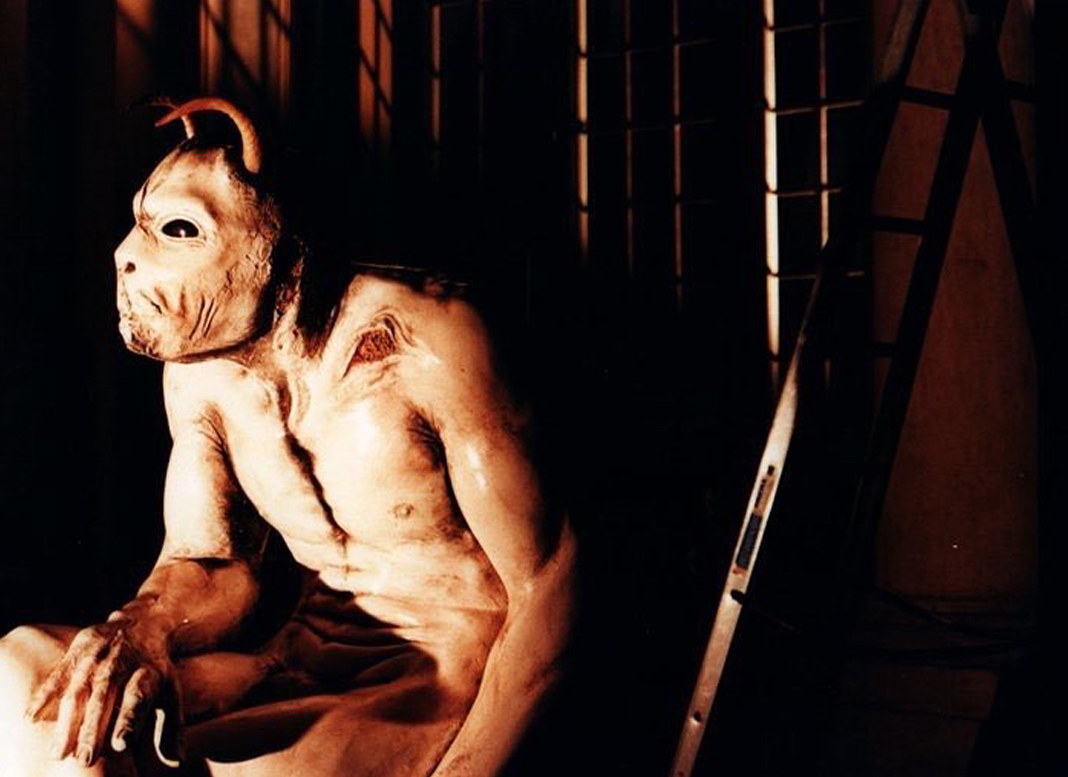
Consciousness, steel and plaster, h 170 cm, 1999. Giuseppe Corrado is well known by an extraordinary work from 1999 which is Conscience. It is a monumental work, in steel and plaster, 170 cm high, called by many as hastily (but not mistakenly) as the devil. The extraordinary nature of this work consists in the fact that, with immediacy, it produces an emotional experience of shock for the observer and, subsequently, an intensity of emotions that make the subject feel (almost) the proof of being attacked from an unspeakable wickedness he never thought he would possess. It is that sinister and ambiguous charm that is typical of a sacredness that emanates from what is terrible and terrifying. The work represents the humanization of evil and therefore, in some respects, transplants Satanism in each of us on the basis of that negative existentialism that considers life a Manichaean struggle between good and evil, in which it is easier than evil triumphs over moral virtues than the opposite.
Not for this, however, Giuseppe Corrado turns to nihilism. On the contrary, the theme of conscience, contained in the caption, certainly not accidentally, wants to exhort to always resume the struggle for good, in terms of a Leopardian humanism that repudiates any form of resignation. The ethical-Christian background and a certain resistance vitalism are, very often, operating in the form of a lively cultural conditioning on his sculptures.
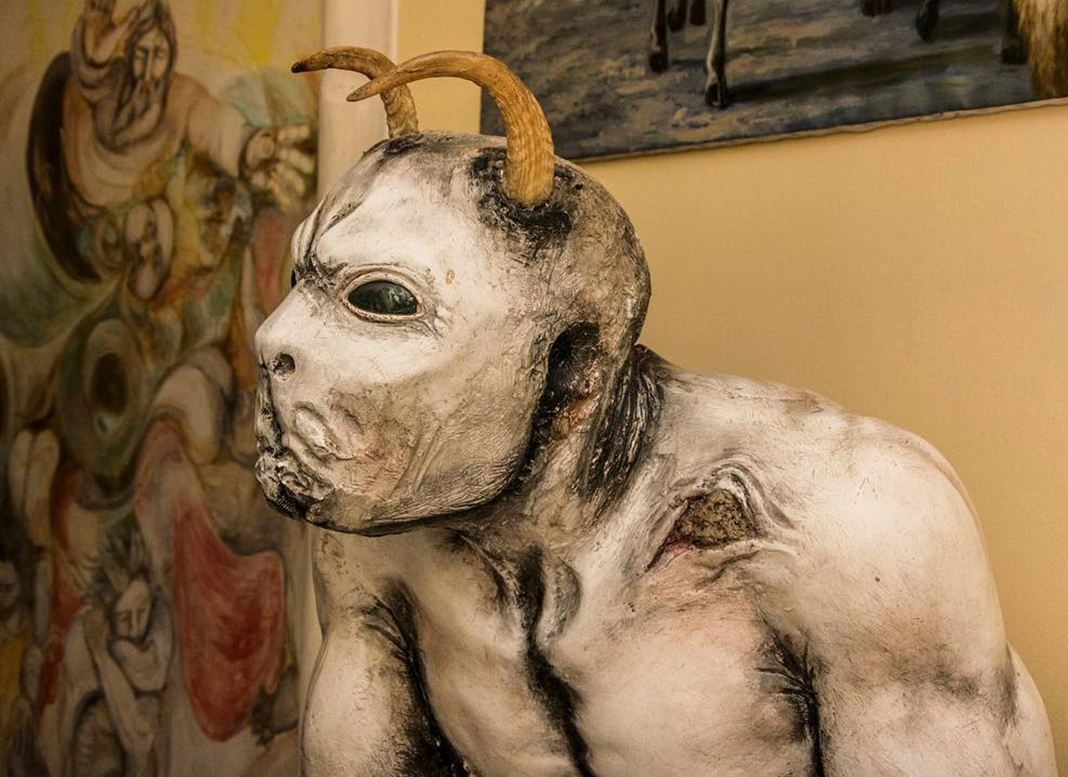
The work demonstrates that the existential problem is translated into a sculptural language that contains in itself evident mythical presuppositions and sacred resonances. It develops, insistently, in a dual approach. The first comes from Hellenistic polytheism and is characterized by a recurring symbolic use of mythical fables, while the second is characterized by an adherence to sacred art of a Christian-medieval matrix. However, these are not phases in a dialectical sense since Christian-ancient art should not be understood as a monotheistic religion that goes beyond Hellenism and mythological traditions.
The interest of Giuseppe Corrado is more for the sacred than for faith and orthodoxy and, therefore, the two moments (Hellenism and Christianity) reappear, cyclically, without ever overcoming one or the other and, indeed, sometimes they are mediated in an aesthetic hybridization which, apparently, seems to dissolve them, but in reality it contains a process of problematic meaning.
Exhibition Activities in Italy: A Restless Traveler

Giuseppe Corrado Art Gallery. Giuseppe Corrado has created a very intense and incessant exhibition activity in Italy and abroad. A very demanding program through which it has made itself known and admired, reaching a wide reputation and a punctual appreciation by art critics.
In the early years of his activity, he exhibited exclusively in Salento and began to maintain a constant relationship with an ecclesiastical client. These are years in which apprenticeship and self-promotion, the study of the classics, the knowledge of the artistic environment and the definition of one's aesthetic taste are intertwined in a personality who lives art with a frenetic and irrepressible Dionysian spirit. These are also the years in which the artist renounces, for understandable reasons, his prerogatives, occasionally practicing craft experiences, but he has never hidden this need and, often, in the light of his humility, he claims that the artist has something to learn from the craftsman.
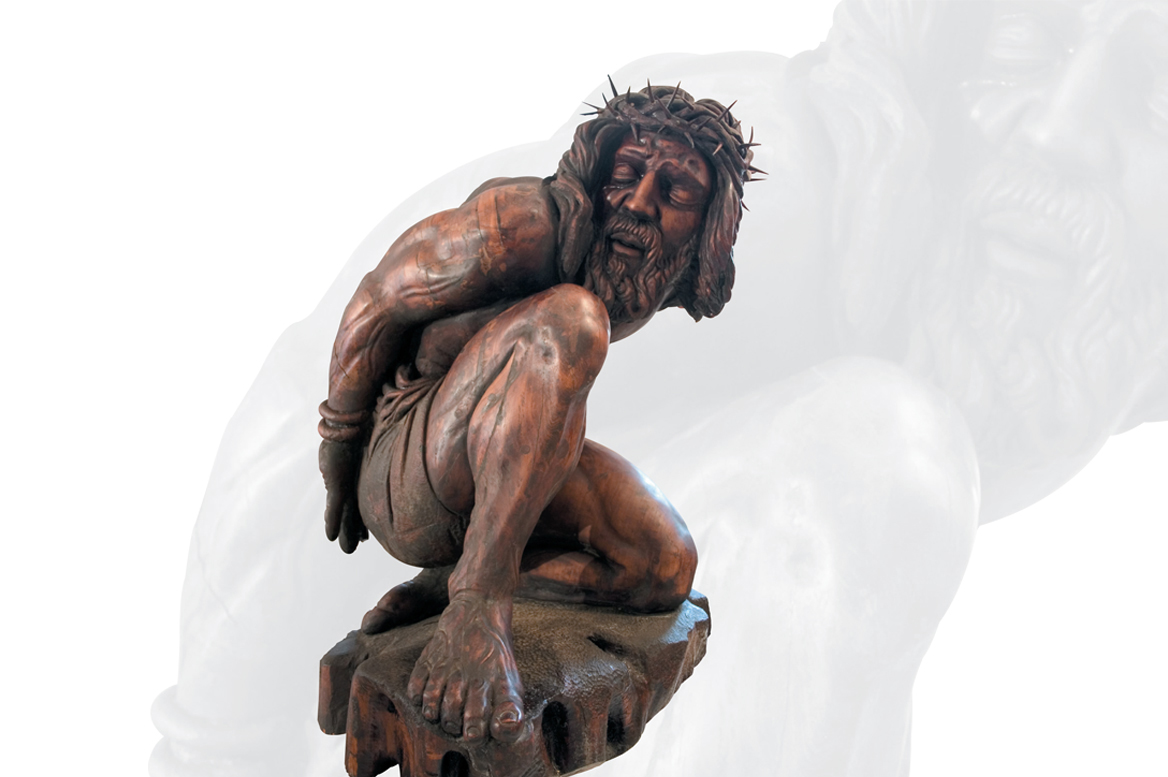
Suffering, olive tree, However already in 1990, at the age of thirty, things changed radically with the participation in two exhibitions in Rome, in one of which he won the Leonardo da Vinci Prize. It is the turning point and things change radically. Since then, he traces a formidable path of exhibition activity in Italy and abroad: exactly from 1989 to 2009 he is continuously present with at least four or five stages a year. A sabbatical two-year period follows: 2010 and 2011.
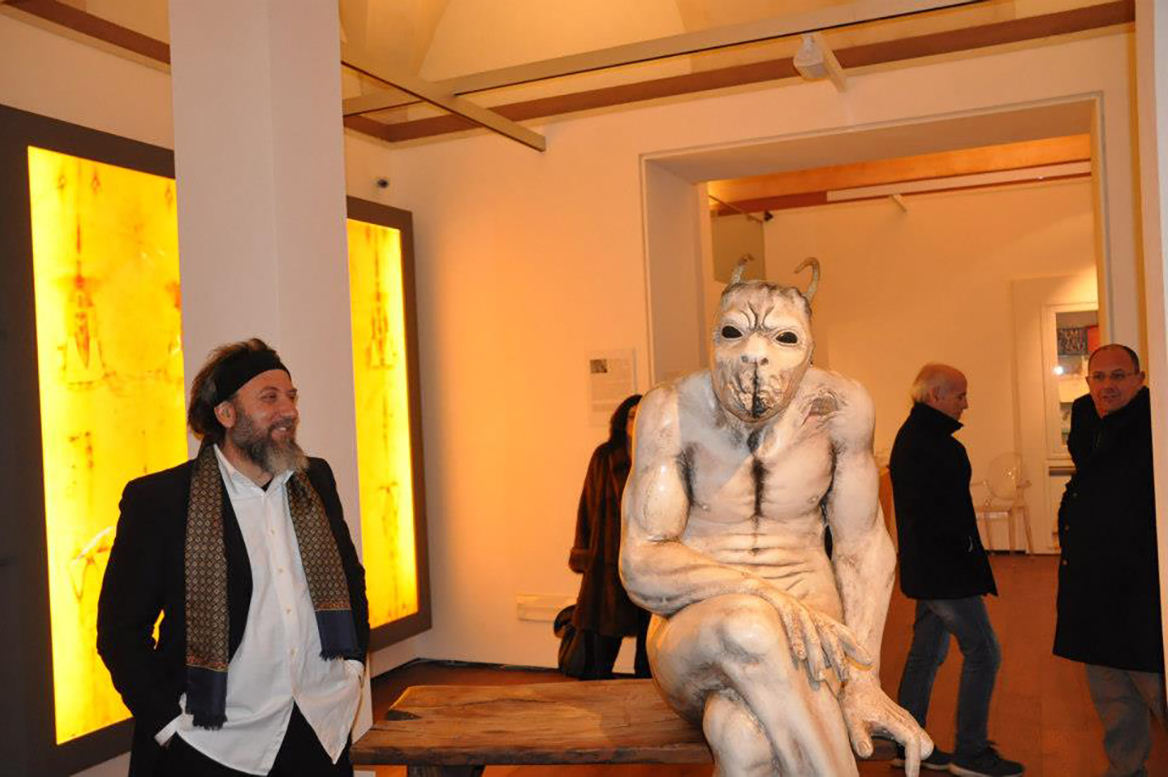
Consciousness, steel and plaster, h 170 cm, 1999, inauguration of the exhibition "Sacrifice and Silence" Biffi Arte Gallery, Piacenza 2013. The exhibition activity resumes in 2012 in Piacenza, involved in an initiative of high multicultural relevance at the Biffi gallery Art. Its exhibition presence is recorded in Rome nine times: in 1990, 1991, 1993, 1994 (twice), 1996 (twice), 1997 and 2002. It is also present several times in Milan, Florence, Modena, Ferrara, Padua , Brindisi, Teramo and Catanzaro.
International Exhibitions: A Global Wanderer

Prison, technique and mixed materials treated, 2014. Giuseppe Corrado is also very active in international exhibitions. In the same period of time, that is from 1990 until today, its presence has been almost constant, with the exception of 2000 and the last five years. From 1990 to 2008 he wanted to bring his sculptures to other ethnic, cultural and national contexts for the need for existential dialogue and cultural interaction, which has already been said. In 1990, he exhibited twice in Germany, at Stadthlle Fùrth and at Stadthlle Monaco. In the first he returned in 1991 and 1993, in the second in 1992.
For four consecutive years, starting in 1994, he has exhibited in Hong Kong at The Ritz Carlton. In 1998 he decided to exhibit in South Africa and did so in Johannesburg, but he also returned to Hong Kong, where he exhibited in the same location. In the following year, the itinerary is identical. In 2001 he returned to Hong Kong at The Ritz Carlton, while in the following year he exhibited in Bucharest at the Hotel Flamenco. In 2004 he was in Marbella, Spain and therefore decided to return to Germany after more than a decade. In 2007, he exhibited at the "Markus Tollmann" gallery in Dusseidorfer, while in 2008 he was present in Cologne and Munich. It seems that between Germany and Giuseppe Corrado there is a relationship of elective affinity so much so that the artist intends to return to it. This continuous interaction between Salento, the Mediterranean, Europe and the world makes him a global citizen: perhaps even a kind of glocal vagabond.
The Pluristilismo and The Allegorical Line
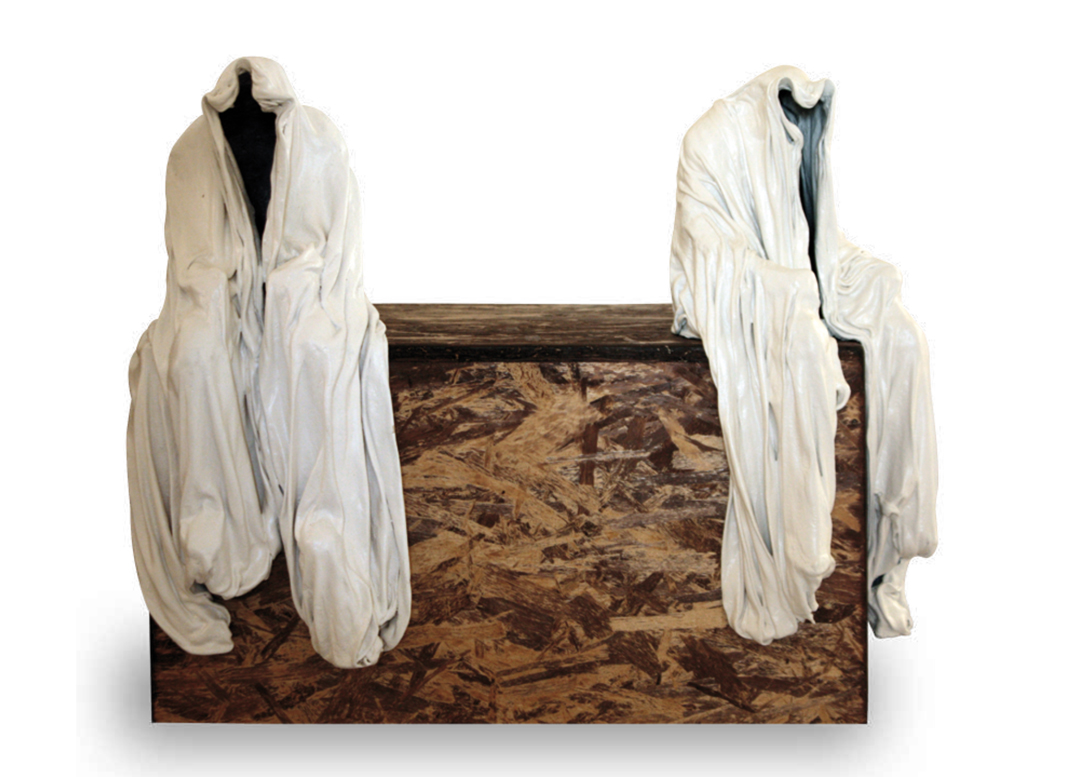
The tedium of dialogue, mixed technique and mixed materials, h. cm 180, 2014. During his long artistic career, Giuseppe Corrado achieved an aesthetic quality and a sculptural construction method that I called pluristilism.
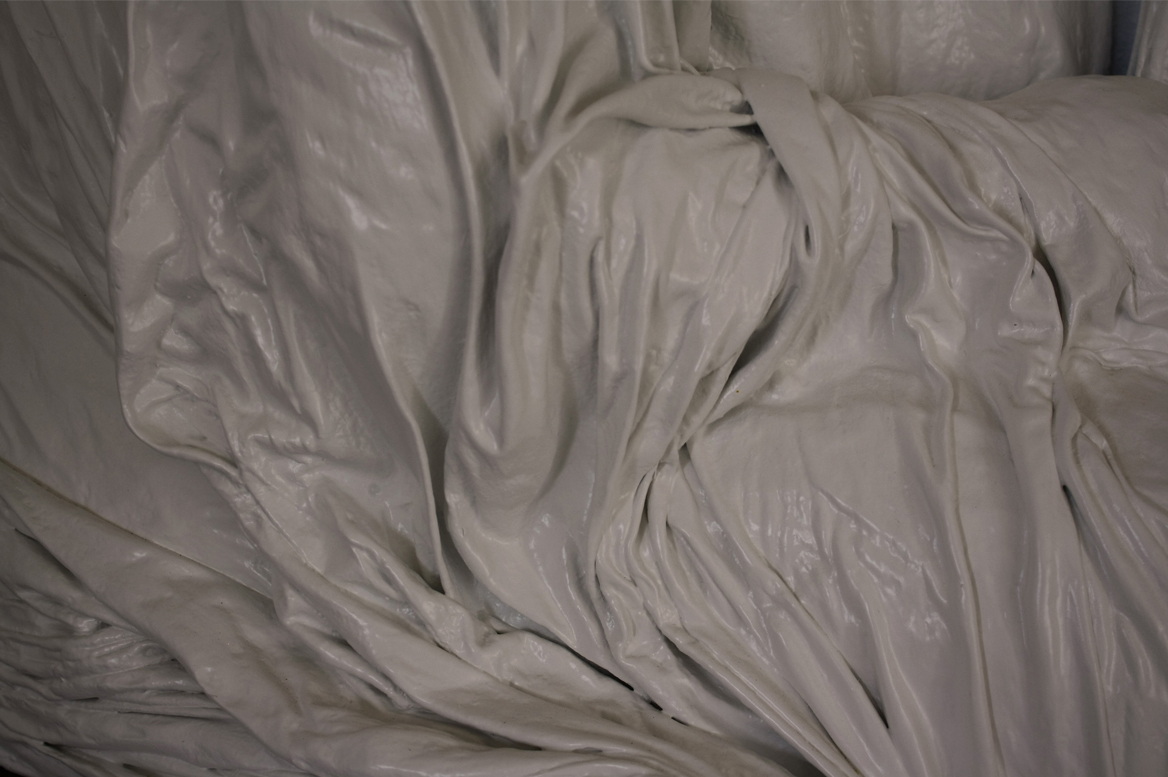
The tedium of dialogue, detail, technique and mixed materials treated, h. cm 180, 2014. To understand the critical value of this word, it is necessary to refer to the concept of multilingualism, which was coined by Gianfranco Contini to explain the language built by Dante Alighieri for his lyrical enterprise. Giuseppe Corrado works in a similar way. At the beginning of a continuous opening towards many styles and expressive tendencies which are integrated and contaminated with great experimental voracity, follows simultaneously a principle of selection and synthesis of those codes used which transmits to his art a meaning of unmistakable originality and, in the at the same time, he frees her from heterogeneity and eclecticism.
In the history of his sculptures, many things are brought back, masterfully, to a unicum, made of aesthetics and ethics, of technique and wisdom, of forms and critical reflection. It should therefore come as no surprise that, in them, mythology and abstractionism, Hellenism and the surreal, the avant-garde and tradition, polytheism and Christian monotheism, anthropology and the Renaissance are traced, merged and intertwined, Baroque and Mediterranean style, expressionism and the informal, conceptual art and sacred iconology of the Middle Ages, a certain calligraphic twilight and the symbolism of the sphere.
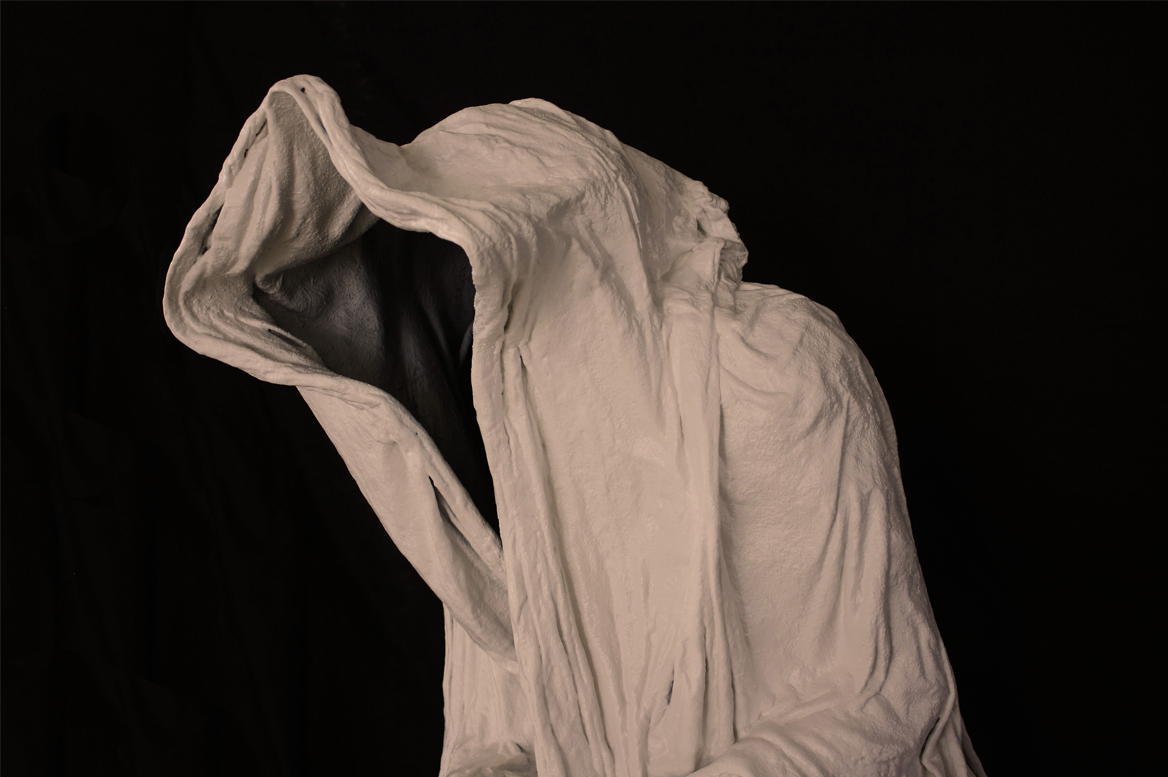
The tedium of dialogue, detail, technique and mixed materials treated, h. cm 180, 2014. Recently, taking up the pleurant figures of French Gothic and integrating them with the method of pluristilism, he has worked on an allegorical line of sculptures that are of extraordinary artistic relevance. And yet, despite this multiple combinatorial frenzy, the impression one gets from his sculptures is always a unicum of aesthetics and sense. Only a great artist can do much.
The Canon of the Pleurants and Its Allegorical Transformation
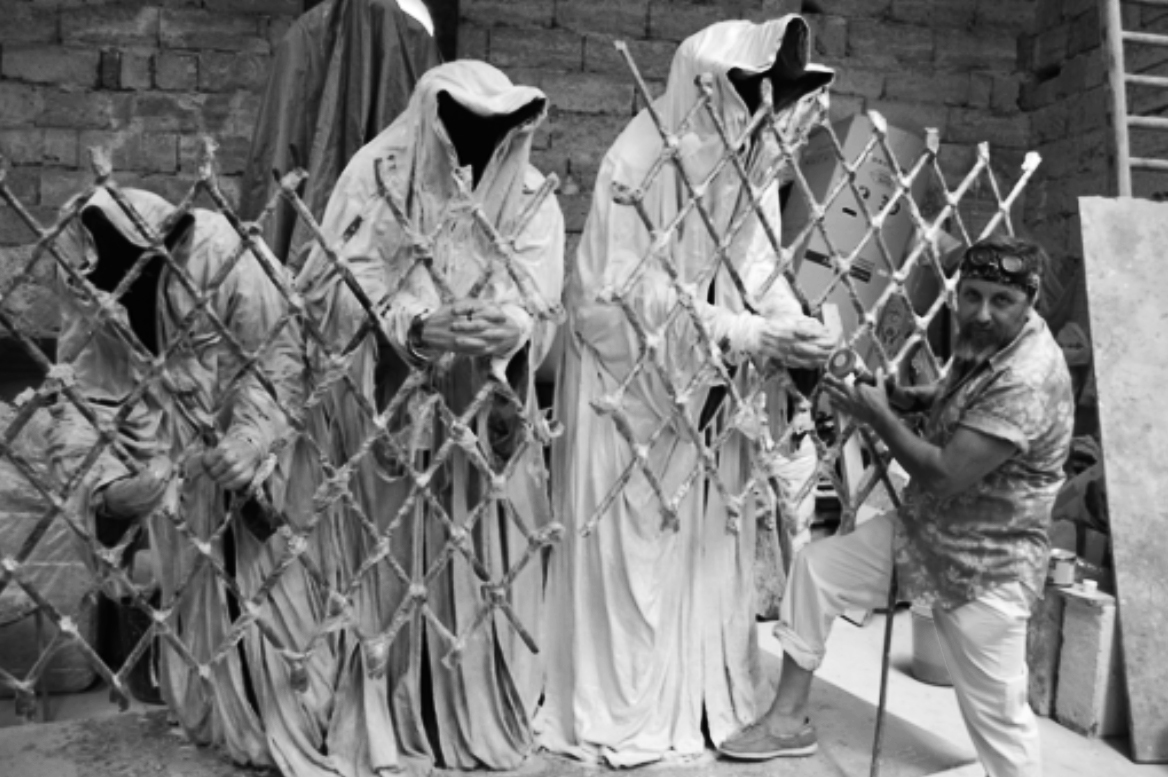
One should not think that the allegorical line is an improvisation in Giuseppe Corrado's sculpture. Anticipations and premises, although not entirely explicit, had already occurred. The previous pages confirm this interpretation. They make us understand that, at least conceptually, the figure of allegory has already made its appearance. His announcement is not a trivial fact and does not even come from a lightning intuition.
The figure of allegory always arrives at sunset, when everything has already been accomplished and tried in vain: all the ways to touch correspondences and harmonies. All the ways, but in an unsuccessful way. After all, all these ways, each with its own plan, have a symbolic device, they aim to be symbolism in a joyful art in knowing how to synthesize particular and universal.

We know that, in the history of Giuseppe Corrado's artistic works, the sacred, the faith, the anthropology, the absolute, the moral virtues, the eternal feminine, the eidos and the search for the origin of bios have beaten, with strength and perseverance, the path of symbolism in order to arrive at a certain correspondence between the particular and the universal or which is the same as a conjunction between Erlebnis and eidos. We called this titanism of art the aesthetic enterprise and we followed its vicissitudes in the stages of the artist's multi-stylism. In each of them, although the symbolic ambition towards harmony is always present, the company has been configured as the dialectic of opposites and this is the reason why Giuseppe Corrado's sculpture is considered an aesthetic of unresolved tension.
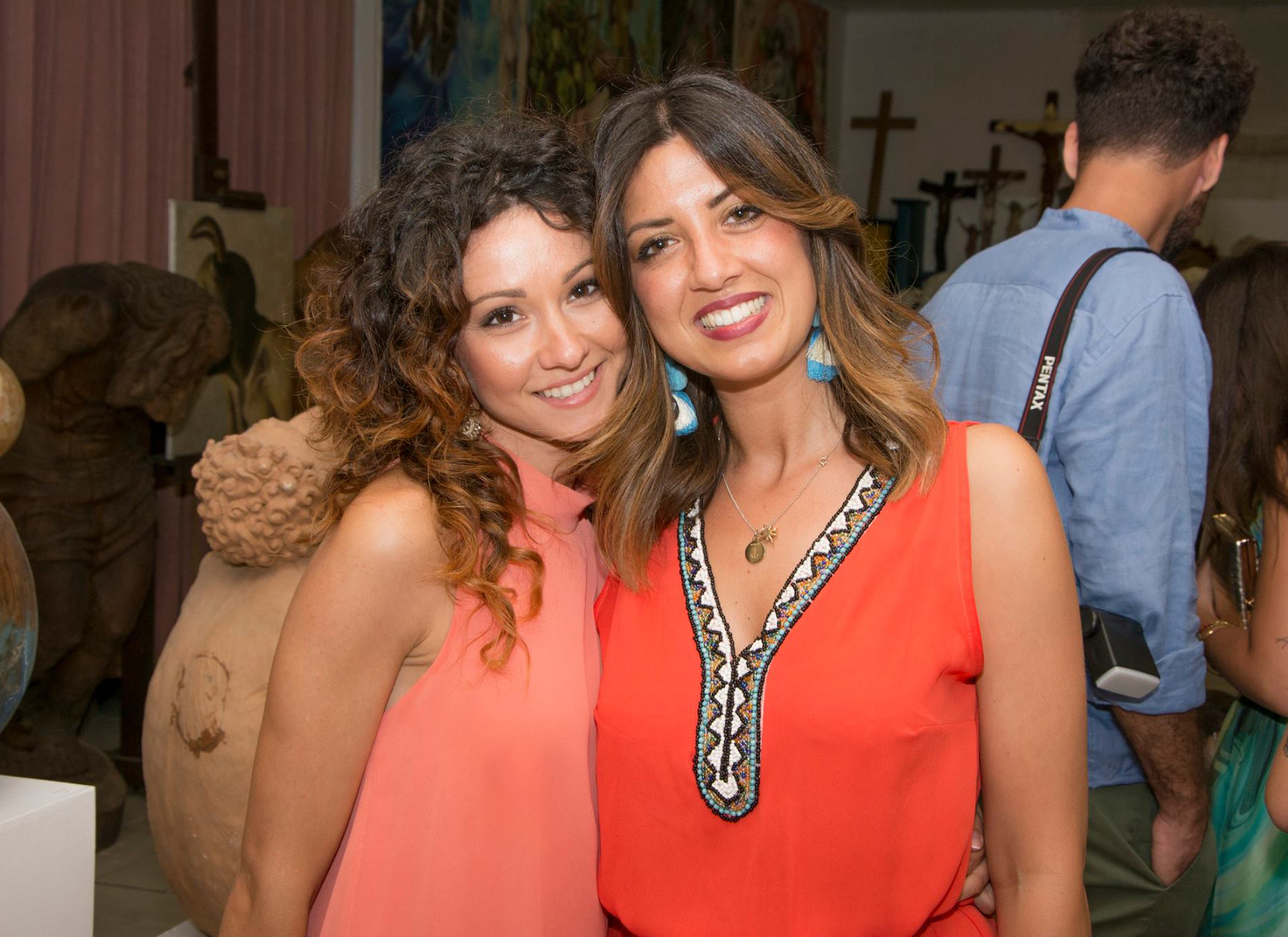
However, the outcome of this venture has been seen to lead to the apocalyptic world view. This is the moment in which the symbolism, with its fundamental axes of the universal and of transcendence, is shattered and, at the same time, the particular, understood as a human individual and a set of natural entities, is reduced to rubble . Apocalyptic naturalism is precisely the threshold from which allegory enters. As soon as it sets foot in the image, there is no more space either for theosophy or even for a thought that sets the goals of the totemic circle or those of the origin and eternal feminine. And the same fate falls to religious thought. From a conceptual point of view, this is the transition from Lebenswelt to Trauerspiel and from the subject's Promethean power to its deconstruction. A real paradigm shift.
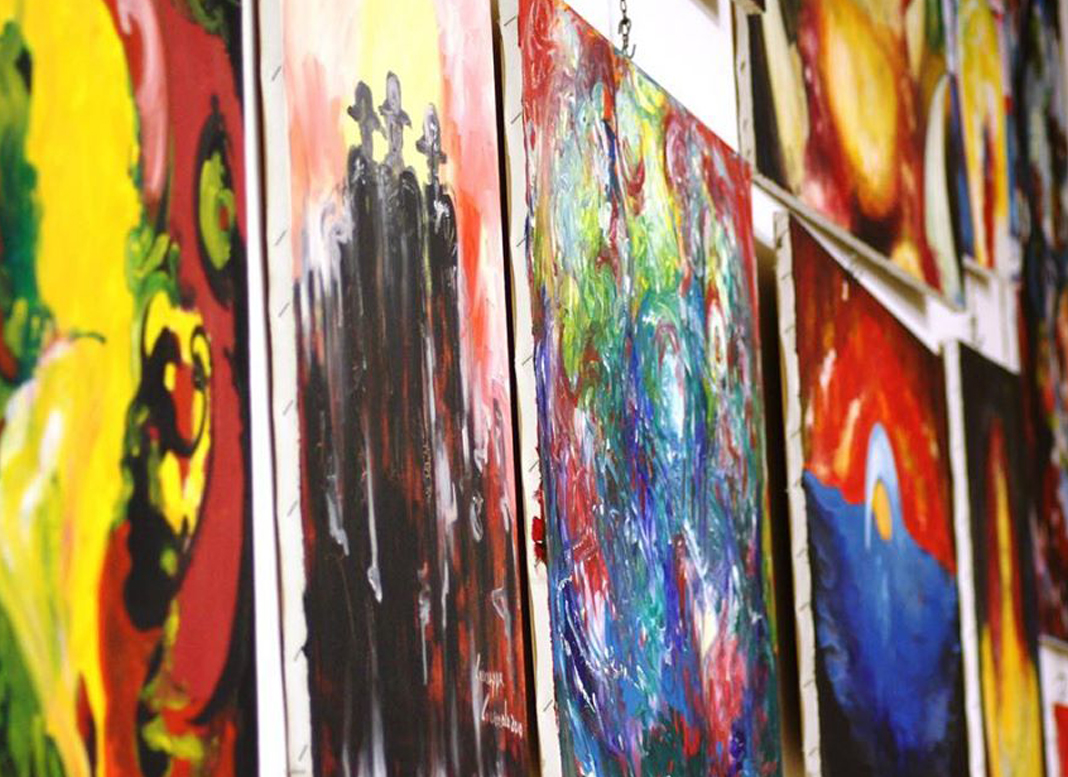
To this clarification, we must add another one concerning the canon of the pleurants. That in the allegorical works, which will be analyzed, there is a resumption of this canon by Giuseppe Corrado is undoubted. Moreover, the correlation seems very clear to me. However, I feel I have to forcefully dismiss the rhetorical assumption of this canon. We are not in the presence of an academic exercise or even a merely mimetic adherence to a canon that comes from the French Gothic. It, that is, the canon of the pleurants, is subjected to an allegorical transformation, which is why in order to understand its meaning one must realize the new cultural paradigm in which it is inserted which is very different, in my opinion, from that to which the medieval pleurants refer in this case it is a paradigm that expresses a monasticism, steeped in asceticism, pauperism and a lot of pietas. I do not think that the medieval figure of the pleurant can be dissociated from a spirituality that unfolds in a fullness, full of expected bliss. It is clear, therefore, that the Gothic canon of the pleurants cannot be explained, if one does not refer to the rigid practice of a mendicant devotion, opposed both to the mundaneization of the clergy and to the theocratic and temporalistic project of the Roman papacy.
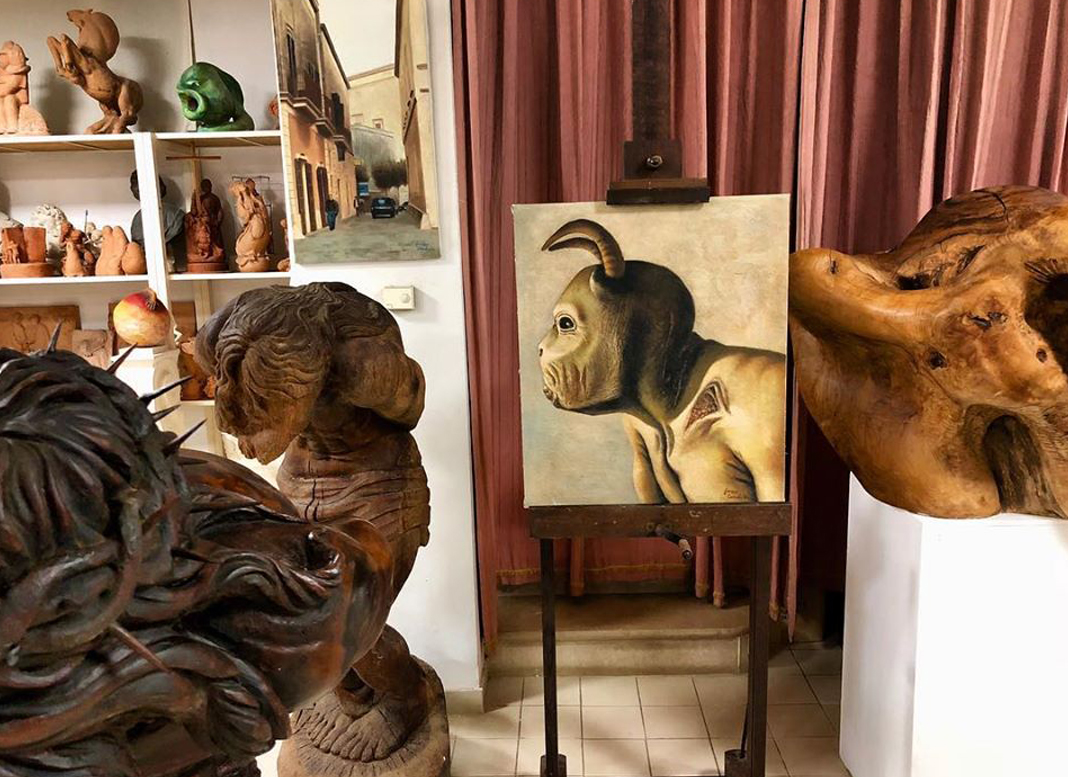
The last five years of his life are marked by a continuous struggle, the real one, the one always represented in his works. Struck by a serious illness, he left this world on March 12, 2016. A few days after his death he received the post of university teaching at the Academy of Fine Arts in Lecce.
Gloria and Niki Corrado - Giuseppe Corrado Association
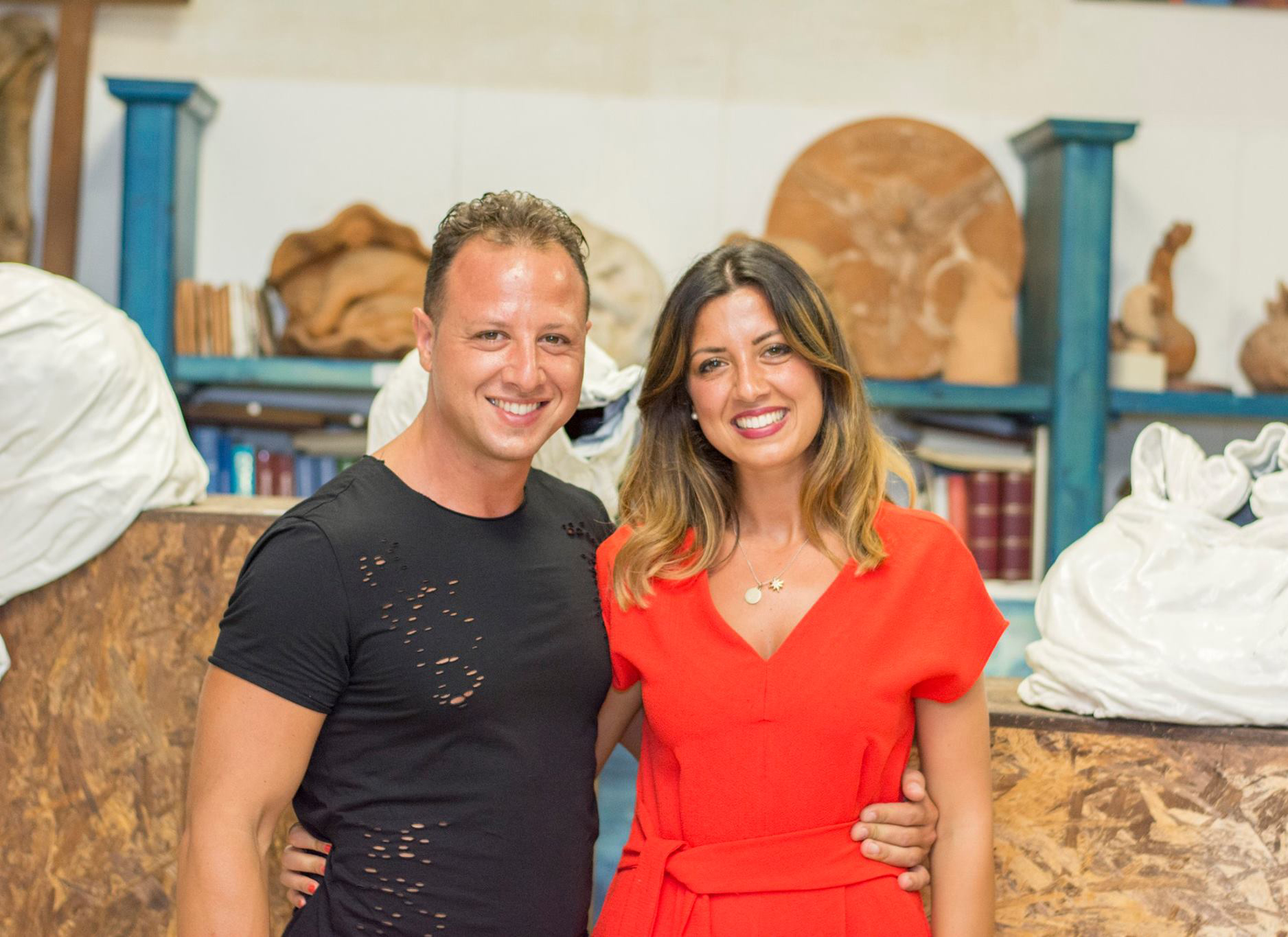
Gloria and Niki Corrado carry on the values transmitted by their father with passion and dedication. The "Giuseppe Corrado" artistic and cultural association was founded, of which Gloria is the president. The only goal is to promote and enhance the name of the artist, his work and everything around him. A figure of this thickness cannot remain jealously hidden in the memory of those who love him or those who have known him, but must live, pulsate, fascinate, become a possible life proposal, here is the sense of association: to keep the memory of Giuseppe Corrado, deepen his knowledge and spread it. The essential task of every live gallery is the exhibition of works of art in multiple forms, research and actuality of cultural promotion, communication of a deeper meaning to visitors and collectors, an opportunity for discussion and dialogue between those who "make art", in in other words, those who learn, promote, distribute, collect. A network where you can consume art and enjoy it.
Giuseppe Corrado
Biographical Notes: A Radical Choice of Life

Giuseppe Corrado was born on January 1, 1960 in Montesano Salentino, in the province of Lecce. At the age of 14, he enrolled in the Artistic Lyceum of Lecce, where he graduated and subsequently decided to enroll in the University of Sports Sciences in Foggia. After obtaining this further qualification, he starts for a short phase of his life at school as a physical education teacher, but that "guerrier spirit that enters me roars" (a creative fury, experienced as a pleasure principle irrepressible) leads him to drop out of school and devote himself to the activity of sculptor and painter.

So he makes a radical and unconventional lifestyle choice. The choice of a petty-bourgeois life, protected from any risk and danger, would have been much more accommodating and safe. As is evident, in this choice, there is a great desire for transgression and rupture, but also an unshakable trust in one's artistic means. It is a choice that totally involves his family, starting with Anna Maria, his splendid wife. However, to tell the truth, his four children have also fully integrated into this modus vivendi.

He, in a very short time, clarifies, first of all to himself, his attitudinal inclinations and, for this reason, he decides to devote himself essentially to sculpture. Do not hesitate to return to the art books. He studies the Greek-Latin classics, medieval iconography and the Italian Renaissance, without however consecrating tradition in dogmatic assumptions. He also begins to be interested in avant-garde and experimentation, but avoiding the easy enthusiasm of conformism and fashion.

Giuseppe Corrado alternates painting with sculpture, but sculpture is soon to establish itself as a prevalent activity (although he will never completely abandon the canvas). He reads a lot and follows the modern debate on art, the extreme theses of the various schools and the many controversies that follow. Its favorite author is Giulio Carlo Argan. It is through these multifarious interests that he begins to form an aesthetic taste, destined to become his style.

When he begins this adventure, he is 22 years old, but that "warrior spirit" roared in his soul, for almost a decade, a period in which the dispositions of the nature had already disciplined the hand and achieved results. The phase of doubt and, therefore, of the co-presence, between the teaching activity and the artistic activity, is over forever. Giuseppe Corrado has never regretted his radical choice.
Paris: A Prestigious Award

Thirty abundant years have passed since the first naive experiences of Giuseppe Corrado and many tests have been faced and brilliantly passed: school, training, assimilation of models, the search for one's own language and also the achievement of a substantial reputation . There are also many critical voices that have recognized the artistic value of his works and not only in Italy. The confirmation comes from a prestigious cultural recognition, attributed to him in June 2012 in Paris, a city that evokes, on a planetary level, suggestions of excellence in the field of the arts, creativity, culture and research. Here he was awarded, during a solemn ceremony, the Diplôme de Médaille d’Argent in Art and was, at the same time, identified as the best living Italian sculptor.
A truly exceptional achievement. The prestigious award is the result of a careful selection work, carried out by experts in the sector who carried it out over a long period of time on the mandate of the "Arts-Sciences-Lettres" -Societé Académique d'Education et d ' Encouragement. It is an association that has been operating since 1915 with fairly strict criteria in identifying excellence, the validity of which is, moreover, unanimously recognized within the cultured community. Amazement and satisfaction are the feelings with which Giuseppe Corrado received the news, however, lived with the usual spirit of humility, being his soul devoid of worldly inclinations and vainglory. The official ceremony, during which he received the Diplôme de Médaille d’Argent, took place on June 16, 2012 at the Hotel Intercontinental Paris le Gran in Paris. It was attended by well-known personalities from the world of culture, the arts and entertainment, as well as leading figures from the political, journalistic and civil society world. A great success both for the public and for critics.
Mediterranean Roots and Cosmopolitanism: Nelson Mandela

Giuseppe Corrado is an artist who knows how to combine the cosmopolitan openness of his sculptures with the solidity of very deep anthropological roots. For this reason, the Mediterranean and the world are two interchangeable dimensions and, in both, the negative existentialism of the human condition is hosted. He assumes that ethno-place that is the Mediterranean, that is, a symbolic-cultural system, mixed with land and sea, as if it were the archaic centrality of a remote world, still significant and not as a moribund periphery. And here, in his works, the re-proposition of Hellenism and classical mythology in a perspective, however, contemporary. And here, again, that baroque sui generis and dramatic that makes one think of the metaphor of storms and an instability of being that gradually passes from aesthetics to anthropology to ethics. In this perspective, the Mediterranean itself expands towards the meaning of the global world.
It would be wrong, however, to think that the myth of the roots was experienced by Giuseppe Corrado as a hermetic entrenchment in an ahistorical vision of those cultural symbolisms, anthropologically linked to Mediterranean civilizations. He has a very open vision of art to such an extent that his need for conviviality between cultures has led him to consider the Mediterranean-World space as the most suitable to show his works, to let them unleash emotions in their abilities receptive to very different peoples and distinguished personalities.

Jesus, olive wood, 1994. Giuseppe Corrado is a cosmopolitan sculptor for wanting to bring a message of critical reflection and peace to many places in the world, from the most important Italian and European cities to Hong Kong and South Africa. Famous in this sense is the great wooden Jesus, donated in 1994 to Pope John Paul II and the embrace with Nelson Mandela, in 1998, to whom he paid homage to one of his important works entitled the Salento Sun. He feels he belongs to a world agora and that the very existential problem of his sculptures feeds on the expectations removed from this audience. His artistic cosmopolitanism leads him to have a humanitarian vision of the relationships between individuals, peoples and races. This is why he lives the words of Nelson Mandela like those of a great modern prophet.
The Existential Problematic Between Hellenism and Christianity

Consciousness, steel and plaster, h 170 cm, 1999. Giuseppe Corrado is well known by an extraordinary work from 1999 which is Conscience. It is a monumental work, in steel and plaster, 170 cm high, called by many as hastily (but not mistakenly) as the devil. The extraordinary nature of this work consists in the fact that, with immediacy, it produces an emotional experience of shock for the observer and, subsequently, an intensity of emotions that make the subject feel (almost) the proof of being attacked from an unspeakable wickedness he never thought he would possess. It is that sinister and ambiguous charm that is typical of a sacredness that emanates from what is terrible and terrifying. The work represents the humanization of evil and therefore, in some respects, transplants Satanism in each of us on the basis of that negative existentialism that considers life a Manichaean struggle between good and evil, in which it is easier than evil triumphs over moral virtues than the opposite.
Not for this, however, Giuseppe Corrado turns to nihilism. On the contrary, the theme of conscience, contained in the caption, certainly not accidentally, wants to exhort to always resume the struggle for good, in terms of a Leopardian humanism that repudiates any form of resignation. The ethical-Christian background and a certain resistance vitalism are, very often, operating in the form of a lively cultural conditioning on his sculptures.

The work demonstrates that the existential problem is translated into a sculptural language that contains in itself evident mythical presuppositions and sacred resonances. It develops, insistently, in a dual approach. The first comes from Hellenistic polytheism and is characterized by a recurring symbolic use of mythical fables, while the second is characterized by an adherence to sacred art of a Christian-medieval matrix. However, these are not phases in a dialectical sense since Christian-ancient art should not be understood as a monotheistic religion that goes beyond Hellenism and mythological traditions.
The interest of Giuseppe Corrado is more for the sacred than for faith and orthodoxy and, therefore, the two moments (Hellenism and Christianity) reappear, cyclically, without ever overcoming one or the other and, indeed, sometimes they are mediated in an aesthetic hybridization which, apparently, seems to dissolve them, but in reality it contains a process of problematic meaning.
Exhibition Activities in Italy: A Restless Traveler

Giuseppe Corrado Art Gallery. Giuseppe Corrado has created a very intense and incessant exhibition activity in Italy and abroad. A very demanding program through which it has made itself known and admired, reaching a wide reputation and a punctual appreciation by art critics.
In the early years of his activity, he exhibited exclusively in Salento and began to maintain a constant relationship with an ecclesiastical client. These are years in which apprenticeship and self-promotion, the study of the classics, the knowledge of the artistic environment and the definition of one's aesthetic taste are intertwined in a personality who lives art with a frenetic and irrepressible Dionysian spirit. These are also the years in which the artist renounces, for understandable reasons, his prerogatives, occasionally practicing craft experiences, but he has never hidden this need and, often, in the light of his humility, he claims that the artist has something to learn from the craftsman.

Suffering, olive tree, However already in 1990, at the age of thirty, things changed radically with the participation in two exhibitions in Rome, in one of which he won the Leonardo da Vinci Prize. It is the turning point and things change radically. Since then, he traces a formidable path of exhibition activity in Italy and abroad: exactly from 1989 to 2009 he is continuously present with at least four or five stages a year. A sabbatical two-year period follows: 2010 and 2011.

Consciousness, steel and plaster, h 170 cm, 1999, inauguration of the exhibition "Sacrifice and Silence" Biffi Arte Gallery, Piacenza 2013. The exhibition activity resumes in 2012 in Piacenza, involved in an initiative of high multicultural relevance at the Biffi gallery Art. Its exhibition presence is recorded in Rome nine times: in 1990, 1991, 1993, 1994 (twice), 1996 (twice), 1997 and 2002. It is also present several times in Milan, Florence, Modena, Ferrara, Padua , Brindisi, Teramo and Catanzaro.
International Exhibitions: A Global Wanderer

Prison, technique and mixed materials treated, 2014. Giuseppe Corrado is also very active in international exhibitions. In the same period of time, that is from 1990 until today, its presence has been almost constant, with the exception of 2000 and the last five years. From 1990 to 2008 he wanted to bring his sculptures to other ethnic, cultural and national contexts for the need for existential dialogue and cultural interaction, which has already been said. In 1990, he exhibited twice in Germany, at Stadthlle Fùrth and at Stadthlle Monaco. In the first he returned in 1991 and 1993, in the second in 1992.
For four consecutive years, starting in 1994, he has exhibited in Hong Kong at The Ritz Carlton. In 1998 he decided to exhibit in South Africa and did so in Johannesburg, but he also returned to Hong Kong, where he exhibited in the same location. In the following year, the itinerary is identical. In 2001 he returned to Hong Kong at The Ritz Carlton, while in the following year he exhibited in Bucharest at the Hotel Flamenco. In 2004 he was in Marbella, Spain and therefore decided to return to Germany after more than a decade. In 2007, he exhibited at the "Markus Tollmann" gallery in Dusseidorfer, while in 2008 he was present in Cologne and Munich. It seems that between Germany and Giuseppe Corrado there is a relationship of elective affinity so much so that the artist intends to return to it. This continuous interaction between Salento, the Mediterranean, Europe and the world makes him a global citizen: perhaps even a kind of glocal vagabond.
The Pluristilismo and The Allegorical Line

The tedium of dialogue, mixed technique and mixed materials, h. cm 180, 2014. During his long artistic career, Giuseppe Corrado achieved an aesthetic quality and a sculptural construction method that I called pluristilism.

The tedium of dialogue, detail, technique and mixed materials treated, h. cm 180, 2014. To understand the critical value of this word, it is necessary to refer to the concept of multilingualism, which was coined by Gianfranco Contini to explain the language built by Dante Alighieri for his lyrical enterprise. Giuseppe Corrado works in a similar way. At the beginning of a continuous opening towards many styles and expressive tendencies which are integrated and contaminated with great experimental voracity, follows simultaneously a principle of selection and synthesis of those codes used which transmits to his art a meaning of unmistakable originality and, in the at the same time, he frees her from heterogeneity and eclecticism.
In the history of his sculptures, many things are brought back, masterfully, to a unicum, made of aesthetics and ethics, of technique and wisdom, of forms and critical reflection. It should therefore come as no surprise that, in them, mythology and abstractionism, Hellenism and the surreal, the avant-garde and tradition, polytheism and Christian monotheism, anthropology and the Renaissance are traced, merged and intertwined, Baroque and Mediterranean style, expressionism and the informal, conceptual art and sacred iconology of the Middle Ages, a certain calligraphic twilight and the symbolism of the sphere.

The tedium of dialogue, detail, technique and mixed materials treated, h. cm 180, 2014. Recently, taking up the pleurant figures of French Gothic and integrating them with the method of pluristilism, he has worked on an allegorical line of sculptures that are of extraordinary artistic relevance. And yet, despite this multiple combinatorial frenzy, the impression one gets from his sculptures is always a unicum of aesthetics and sense. Only a great artist can do much.
The Canon of the Pleurants and Its Allegorical Transformation

One should not think that the allegorical line is an improvisation in Giuseppe Corrado's sculpture. Anticipations and premises, although not entirely explicit, had already occurred. The previous pages confirm this interpretation. They make us understand that, at least conceptually, the figure of allegory has already made its appearance. His announcement is not a trivial fact and does not even come from a lightning intuition.
The figure of allegory always arrives at sunset, when everything has already been accomplished and tried in vain: all the ways to touch correspondences and harmonies. All the ways, but in an unsuccessful way. After all, all these ways, each with its own plan, have a symbolic device, they aim to be symbolism in a joyful art in knowing how to synthesize particular and universal.

We know that, in the history of Giuseppe Corrado's artistic works, the sacred, the faith, the anthropology, the absolute, the moral virtues, the eternal feminine, the eidos and the search for the origin of bios have beaten, with strength and perseverance, the path of symbolism in order to arrive at a certain correspondence between the particular and the universal or which is the same as a conjunction between Erlebnis and eidos. We called this titanism of art the aesthetic enterprise and we followed its vicissitudes in the stages of the artist's multi-stylism. In each of them, although the symbolic ambition towards harmony is always present, the company has been configured as the dialectic of opposites and this is the reason why Giuseppe Corrado's sculpture is considered an aesthetic of unresolved tension.

However, the outcome of this venture has been seen to lead to the apocalyptic world view. This is the moment in which the symbolism, with its fundamental axes of the universal and of transcendence, is shattered and, at the same time, the particular, understood as a human individual and a set of natural entities, is reduced to rubble . Apocalyptic naturalism is precisely the threshold from which allegory enters. As soon as it sets foot in the image, there is no more space either for theosophy or even for a thought that sets the goals of the totemic circle or those of the origin and eternal feminine. And the same fate falls to religious thought. From a conceptual point of view, this is the transition from Lebenswelt to Trauerspiel and from the subject's Promethean power to its deconstruction. A real paradigm shift.

To this clarification, we must add another one concerning the canon of the pleurants. That in the allegorical works, which will be analyzed, there is a resumption of this canon by Giuseppe Corrado is undoubted. Moreover, the correlation seems very clear to me. However, I feel I have to forcefully dismiss the rhetorical assumption of this canon. We are not in the presence of an academic exercise or even a merely mimetic adherence to a canon that comes from the French Gothic. It, that is, the canon of the pleurants, is subjected to an allegorical transformation, which is why in order to understand its meaning one must realize the new cultural paradigm in which it is inserted which is very different, in my opinion, from that to which the medieval pleurants refer in this case it is a paradigm that expresses a monasticism, steeped in asceticism, pauperism and a lot of pietas. I do not think that the medieval figure of the pleurant can be dissociated from a spirituality that unfolds in a fullness, full of expected bliss. It is clear, therefore, that the Gothic canon of the pleurants cannot be explained, if one does not refer to the rigid practice of a mendicant devotion, opposed both to the mundaneization of the clergy and to the theocratic and temporalistic project of the Roman papacy.

The last five years of his life are marked by a continuous struggle, the real one, the one always represented in his works. Struck by a serious illness, he left this world on March 12, 2016. A few days after his death he received the post of university teaching at the Academy of Fine Arts in Lecce.
Gloria and Niki Corrado - Giuseppe Corrado Association

Gloria and Niki Corrado carry on the values transmitted by their father with passion and dedication. The "Giuseppe Corrado" artistic and cultural association was founded, of which Gloria is the president. The only goal is to promote and enhance the name of the artist, his work and everything around him. A figure of this thickness cannot remain jealously hidden in the memory of those who love him or those who have known him, but must live, pulsate, fascinate, become a possible life proposal, here is the sense of association: to keep the memory of Giuseppe Corrado, deepen his knowledge and spread it. The essential task of every live gallery is the exhibition of works of art in multiple forms, research and actuality of cultural promotion, communication of a deeper meaning to visitors and collectors, an opportunity for discussion and dialogue between those who "make art", in in other words, those who learn, promote, distribute, collect. A network where you can consume art and enjoy it.
Coming Soon - The Products of This Partnership Will be Available Shortly


